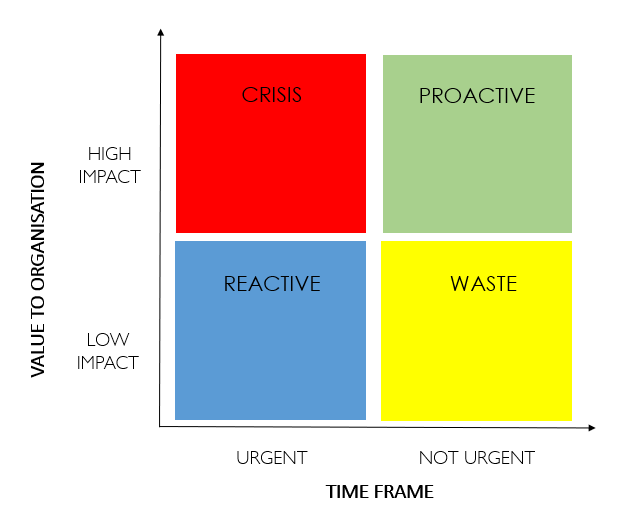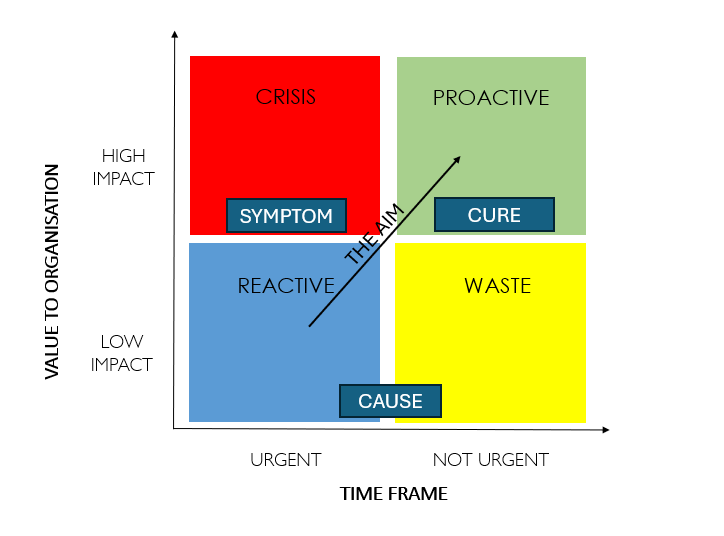- Home
- 7 Steps of Goal Setting
- The Eisenhower Matrix: Your Productivity Blueprint
The Eisenhower Matrix: Your Productivity Blueprint
The Eisenhower matrix is a litmus test for how time and the value of our output interconnect. Developed by Dwight David Eisenhower – the 34th President of the United States (from 1953 to 1961). Faced with making many difficult decisions about which tasks he should focus on, President Eisenhower invented the world famous Eisenhower Method to focus his choice on how to use his time.
Every minute of every day we are exercising choice as to how we spend our time. Sometimes we look back on our day with great satisfaction; sometimes with the frustration that we have been busy all day and nothing has shifted.
The temptation to get sucked down into the vortex of little low value items can destroy
- your plans,
- your achievement,
- your reputation, and
- your self-esteem.
What is the Eisenhower matrix?

The Eisenhower matrix (popularized by Stephen Covey) can be your productivity blueprint which differentiates between Urgency and Importance.
Looking at the Eisenhower matrix diagram below you will see that Urgency is the x axis value. Another way of looking at this is to measure time from Now on the left to Long Term on the right.
Importance or value is measured vertically on the Y axis.
The great news is that all of our time use can be evaluated across this matrix giving us an audit as to the value of how we are spending our time.
The quadrants below depict 4 scenarios:
Quadrant 1: Urgent and Important – where crises occur – time spent here is a must. No choice!
Quadrant 2: Important and Not Urgent – where long term value is hatched and fostered
Quadrant 3: Urgent and Unimportant – where the niggly frustrating stuff happens
Quadrant 4: Neither Urgent or Important - where people are switched off or disengaged
Using the Eisenhower Matrix: Symptoms, Cures and Causes
Quadrant 1 is the Crises quadrant.
The activities that usually sit in this quadrant are important deadlines, pressing but important meetings, emergencies, last minute preparations. Often these activities required immediate action and there is no choice. If you find yourself in this quadrant most of the time then this could be an indication of a symptom of an underlying problem (e.g. poor expectations, a lack of clarity, lack of prioritization, and procrastination to name a few). Being in this quadrant too long is stressful and will likely require stress and time management strategies.
Quadrant 2 is the Proactive quadrant.
The activities that usually sit in this quadrant are relationship building, personal development, employee training, exercise and health, prevention and planning. Spending time in this quadrant is a cure. Most time management principles are aimed at squeezing the time in quadrant 3 (reactive) and spending more time in quadrant 2 (the proactive). The more time in quadrant 2 the less likely you will end up in Crises mode.

Quadrant 3 is the Reactive quadrant.
The activities that usually sit in this quadrant are some emails and phone calls, many interruptions, some popular but low value activities, and some meetings. The aim of time management is to reduce your time in this quadrant as spending too much time in Quadrant 3 is a cause of poor time management. This can be done a number of ways (by saying No more often, streamlining your meetings, batching emails and phone calls, setting up etiquette around emails and interruptions, and so forth).
Quadrant 4 is the Waste quadrant.
The activities that usually sit in this are timewasting and usually fun. They might include spending too much time around the water cooler talking about last nights football match, some trivia, some phone calls, and time wasters.
On a good day, most of our time will be spent in the top of the grid – on the important activity either short term or long term - preferably in Quadrant 2 (Proactive) since this is where sustainable performance lies and too much time in crisis in Quadrant 1 can lead to burnout and exhaustion.
Frustration builds when we have committed our time but we end up on the bottom of the table in the unimportant.
Why then does so much time in the average organization get taken up in the lower levels – particularly Quadrant 3 - the Urgent and Unimportant?
Well…human nature!
Little niggly stuff is often easier than gearing up for the important stuff - and who doesn’t want an easy life?
The biggest gains in your time management can be harnessed by getting clear on your Q2 activities and from reducing your time quadrant 3!
Use the Eisenhower Matrix Template to increase time in Q2
Here we show you how to use the Eisenhower Matrix Template to keep yourself honest and on track with your high priorities. Here are a few tips:
- Map your own life activities in the 4 quadrants. Check in hourly, daily and weekly to monitor how you are really spending your time.
- Get clear about what are your quadrant 2 activities. If you are not sure then check out these ideas.
- Protect your two or three most important activities in advance so that the vital few are not crowded out by the trivial many.
Use the Eisenhower Method to reduce time in Q3
It is frustrating to witter away your time on
- ineffective meetings,
- the deluge of daily emails and social media notifications
- constant interruptions
- information overflow and web distraction.
All these crowd out important stuff that you are measured on.
If you feel that you are working hard but don't have much to show for it, then here are some tips to reduce your time in Q3:
- Protect yourself from the temptations and frustrations of Quadrant 3 by keeping a task list and batching the small stuff in set sessions of your day - for example you can make all your phone calls in a set session. Batching up small actions keeps you on task and can stop you bouncing from one kind of activity to another.
- Schedule set times with finite boundaries for email and other incoming communications, managing your interactions with colleagues, making and taking calls.
- Think of all the stuff that gets in the way of your concentration and question (1) Is this worth doing at all? And (2) Can I corral this activity into a set block of time which suits me and where I am not wasting my most valuable time of the day?
Don't let the trivial many crowd out the vital few!
Have Do You Use the Time Management Matrix
Do you have a great story about this? Share it!
What Other Visitors Have Said
Click below to see contributions from other visitors to this page...
The time management matrix and LifeQuadrants Not rated yet
I use LifeQuadrants to organize my tasks with the time management matrix. LifeQuadrants is specifically designed to optimally support the user in the application …
using the time management matrix to reduce stress and overwhelm Not rated yet
Your article on the time management matrix really showed me how spending time in quadrant 1 can be stressful.
I can see that spending time in the bottom …
Time management matrix advice Not rated yet
Some of the best time management advice I received was to ensure that I plan my work and then work my plan. While I understand this, in terms of the time …
Time management problems and the time management matrix Not rated yet
I have time management problems and was wondering how the time management matrix could provide me with help?
I find that I am spending too much time …






New! Comments
Have your say about what you just read! Leave me a comment in the box below.